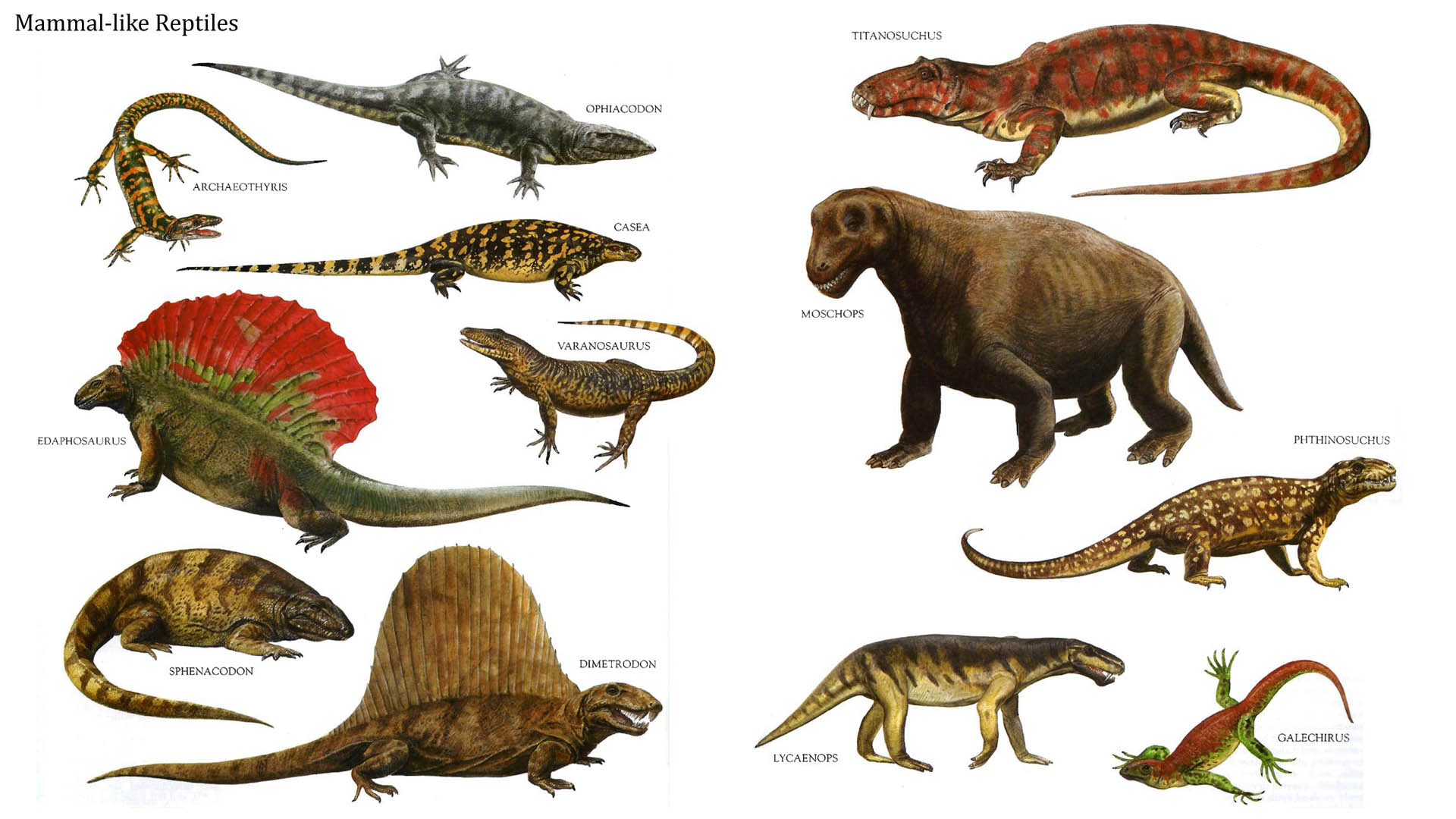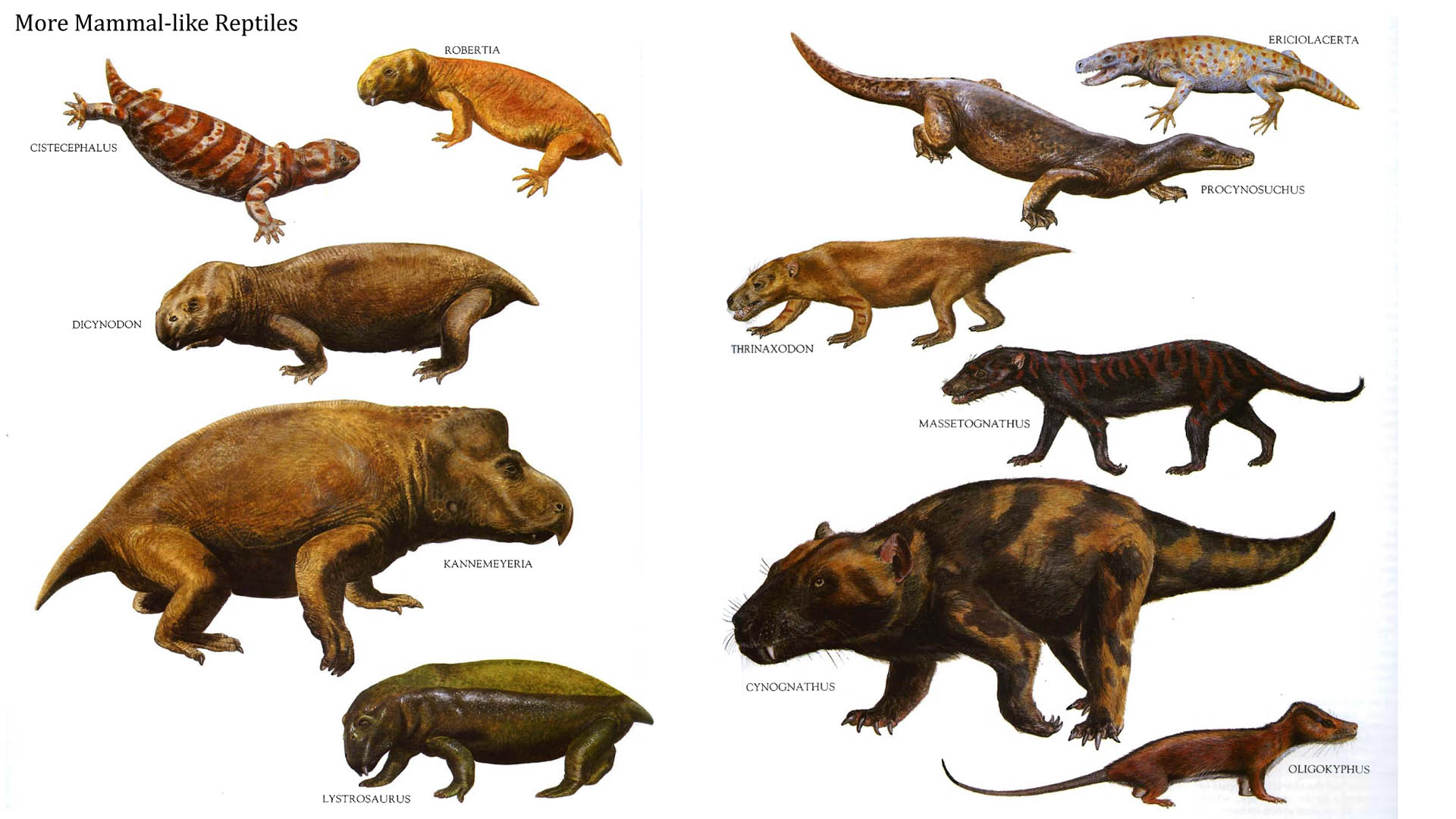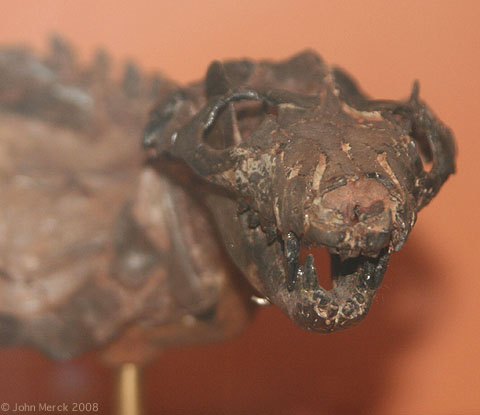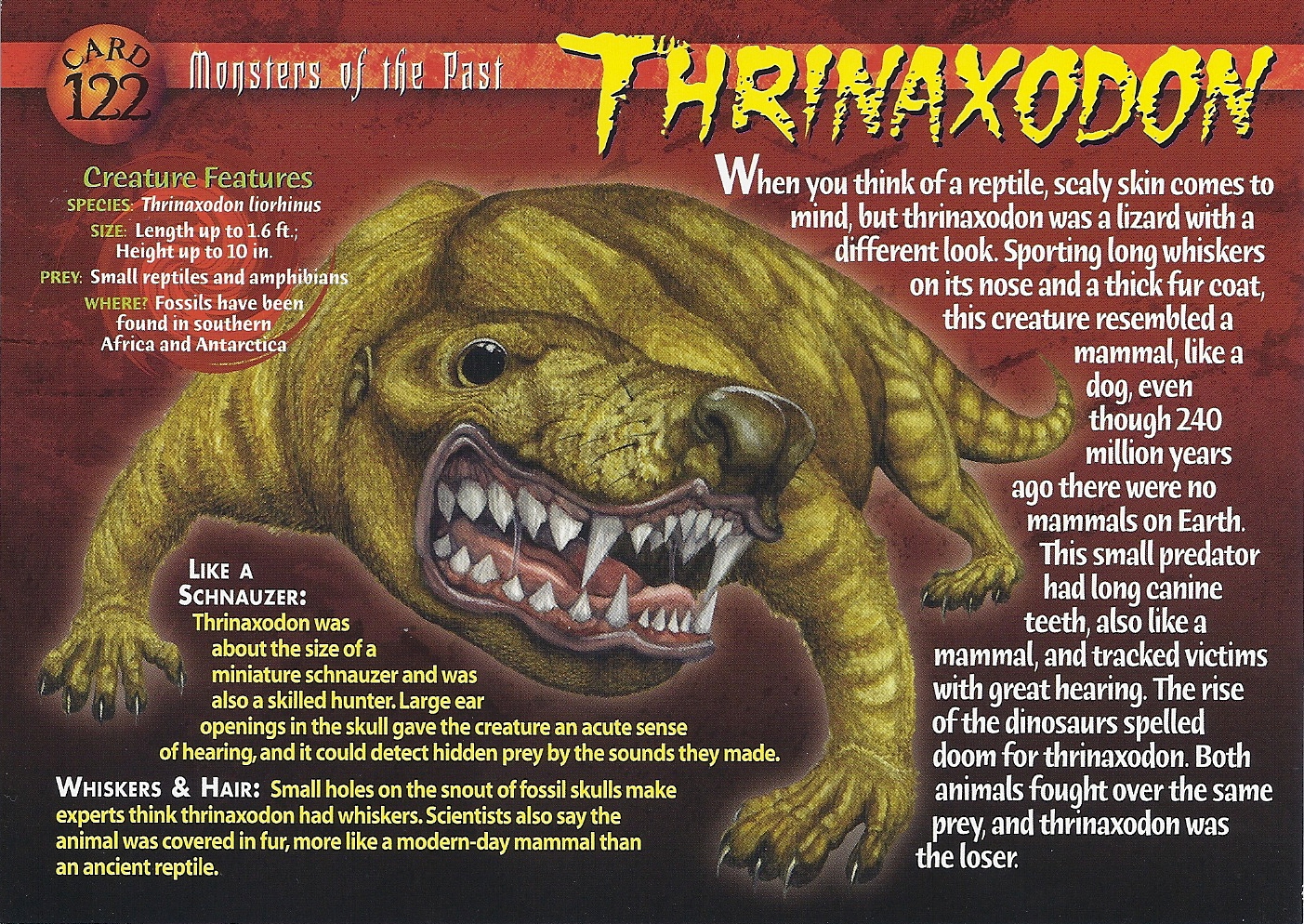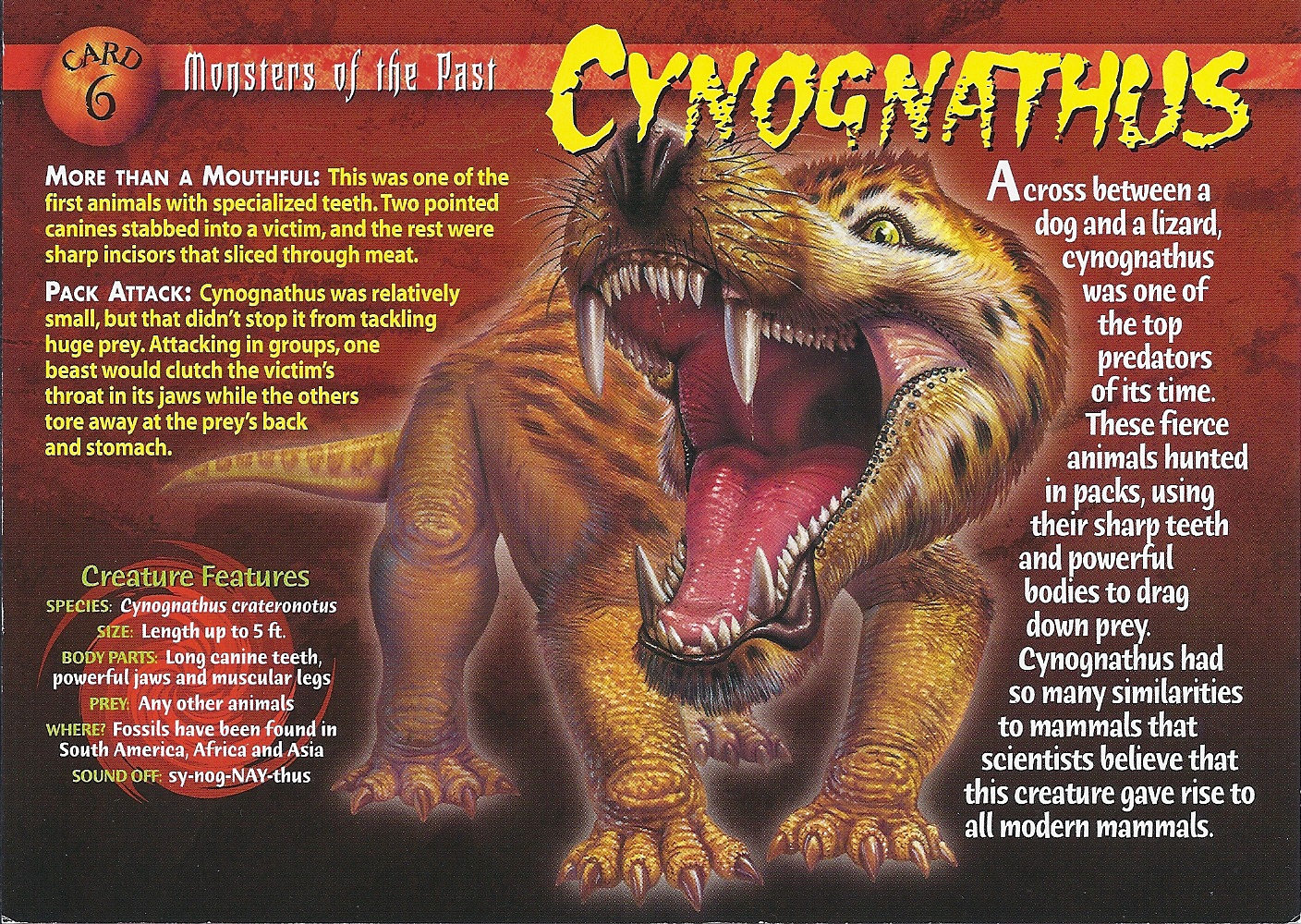Mammal-like reptiles were the highly varied and widely distributed prehistoric reptiles, or more accurately synapsids, that displayed certain traits that are otherwise considered distinct to mammals. Some examples include parental care, thermoregulation, endothermic metabolisms, burrowing, whiskers used as sensory organs, the presence of a diaphragm, enhanced senses, sexual dimorphism, and an erect posture. Mammal-like reptiles eventually became the dominant land animals during the Mesozoic era, around 260 million years ago.
Some theorize that the presence of these mammal-like characteristics, in prehistoric reptiles, may prove that modern mammals, including humans, arose from one or more of these proto-mammals. Therefore this would mean that the Reptiliomorpha clade which includes most reptile-like amphibians eventually gave rise to all mammals, reptiles, and before that the early bony-fish (Osteichthyes.)
The Reptiliomorpha clade is a taxonomic clade within the superclass Tetrapoda – the reptile-like amphibians, which gave rise to the amniotes. Amniotes are animals defined by their ability to lay eggs on land, unlike most amphibians, and tetrapods include most four limbed vertebrates and their ancestors. Both the sauropsids (the ancestors of reptiles and birds) and synapsids (every animal closely related to mammals) are amniotic and began to emerge somewhere around the end of the Paleozoic era, and in the Mesozoic era that followed. Amniotes diverged very early in their evolutionary history into two main lines, the synapsids and the sauropsids - both of which persist into the modern era.
The earliest known fossil for the synapsid is 312 million years old, while the earliest known fossil for the sauropsid is about 306 million years old. This might indicate that mammal-like traits and reptilian-like traits emerged at around the same time. Therefore one did not necessarily evolve from the other but rather shared common ancestors more similar to the reptile-like amphibians. Very few of the non-mammalian synapsids (mammal-like reptiles) outlasted the Triassic period, although survivors persisted into the Cretaceous and are considered, as a phylogenetic unit, to include mammals as descendants.The Mesozoic era has three major periods: the Triassic, Jurassic, and Cretaceous, and is also known as The Age Of The Reptiles.
#1 Oligokyphus
Name: Oligokyphus
Age(s): 227-180 million years ago
Period: Late Triassic-Early Jurassic
Size: 1.5 feet
Location(s) found: UK, Germany, China
Notes:
Oligokyphus were the last members of the non-mammalian synapsids. They are considered to be among the non-mammalian members of the synapsid family and are described as mammal-like reptiles in classical systematics. Originally considered to be an early mammal, it is now classified as a stem-mammal, because Oligokyphus does not have the mammalian jaw attachments. Oligokyphus is in the family Trityledontidae, which means "three knob teeth". The members of this family were all small to medium-sized advanced proto-mammals with combined specialized structures for herbivorous eating.
These animals were extremely active and burrowed in leaf litter and dirt, which suggests characteristics of rodents and rabbits. They had metabolisms that were partially or completely endothermic, meaning they maintained their bodies at a metabolically favorable temperature with mechanisms like shivering. This ability is usually indicative of warm blooded animals. Because the Oligokyphus was in a transitional state from reptilian to mammalian there is a good possibility that it exercised parental care similar to some other prehistoric transitional mammals, most modern mammals, as well as birds and some reptiles.
#2 Thrinaxodon
Name: Thrinaxodon
Age: 251 million years ago
Period: Early Triassic (Induan)
Size: 1.5 feet
Location(s) found: South Africa (Free State Province), Antarctica
Notes:
The Thrinaxodon is often considered a transitional fossil because it is closely related to the lineage that leads directly to mammals. Clues to it's remains show that this creature was more mammal-like than even the Thrinaxodon's synapsid ancestors, which suggests a process of evolution leading to the mammal-like animals we see today. It had a fairly large head/skull, with pits in the snout, which may indicate that it had whiskers. Although some modern reptiles, like the Tupinambis lizard, has pits in the same area of the skull which are almost identical. Also, like it's predecessors, the Thrinaxodon laid eggs, and there were many reptilian features in its skeleton. It's remains were found on South Africa and Antarctica, supporting the notion that the two continents were once joined together.
In response to the wide daily temperature swings of the early Triassic, the Thrinaxodon may have become eurythermic (the ability to function at a broad range of temperatures.) We know the Thirnaxodon was endothermic (the ability to regulate core temperatures from within) and as result of the extreme daily temperature swings of the early Triassic, the processes of homeothermic endothermy could have evolved over time. This means that the Thirnaxodon was probably among one of the first animals that could maintain it's body temperature at a favorable degree, without the help of external ambient heat or outside sources, and instead regulated it's core temperature thorough homeostasis. Although not all homeothermic organisms are endothermic organisms, as some must maintain constant body temperatures through behavioral mechanisms alone. For example, reptiles must bask in the sun or some other heat source to remain active but will revert to a stasis, or a period of inactivity, in cold temperatures. This means that the Thirnaxodon was among some of the first animals to develop this combination of biological processes to enable it to maintain a core body temperature at a favorable degree, without the help of external ambient heat. This would have given it a considerable evolutionary advantage.

Endothermic organisms accomplish this by releasing heat from internal processes as a major factor in controlling their body temperature. Because endothermic animals have a large number of mitcochondria per cell, they can generate heat by increasing the rate at which they metabolize fats and sugars. In the cold, an endothermic animal is able to reserve heat by dropping their core bodily temperatures to below of those required to maintain homeostasis, a method is known as hypothermia. Functions like shivering also help with the process. When exposed to heat, various functions in different organisms are exhibited to control core temperatures. For example, panting is used by dogs to cool down, ear flapping by elephants, and sweating by humans.
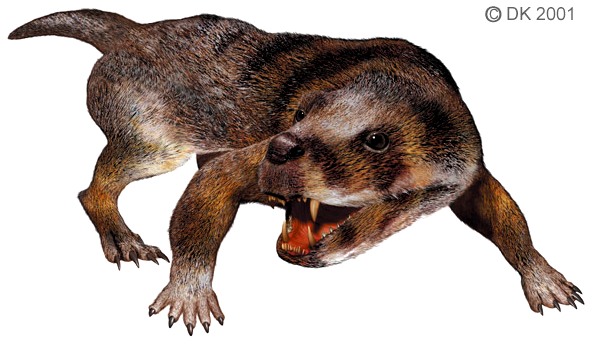
This capability may enabled the Thirnaxodon and subsequent animals that evolved this ability to withstand colder nights in order to nocturnally pursue prey, as they would not have needed a heat source like the sun to stay active. Nocturnal habits would have increased their diet exponentially, as many insects were active at night, there would have been less competition for prey animals, and the dim lighting would have made it hard for their prey to see.
In fact, researchers once thought that the transition to nocturnality most likely began about the same time mammals evolved, about 200 million years ago. But new studies suggest nocturnal activities might be much much older than previously suggested, as much as 100 million years earlier, and may have actually began with mammal's ancient synapsid relatives (mammal-like reptiles.)
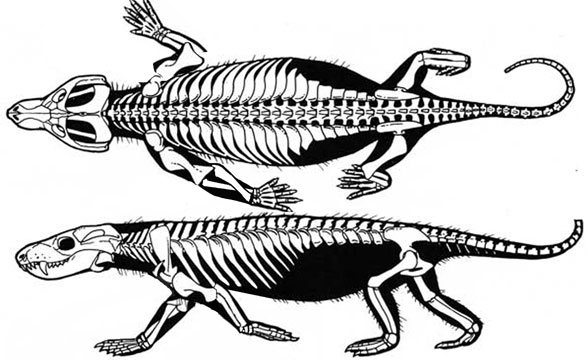
The researchers found that the eyes of one of the oldest observed mammal-like reptiles, the carnivore Dimetrodon (#5 on this list), had dimensions in its eyes that signified nocturnal activity; this suggests nocturnal activity developed 100 million years earlier than the time of the first mammals.
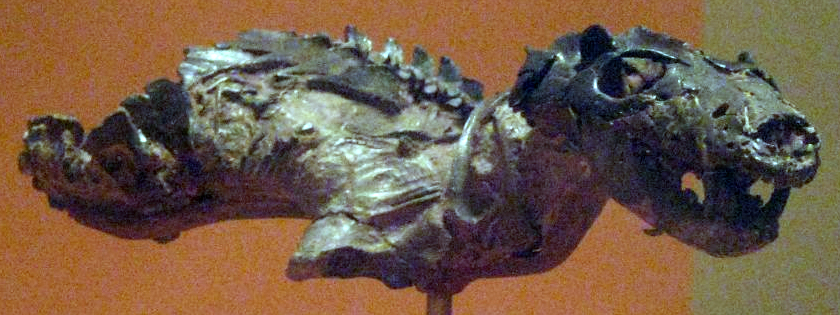
The findings of the study is said to be useful to researchers examining the behavior and visual systems of living mammals, among other issues. In addition, the research means that scientists will need to rethink some long-held ideas, such as mammals becoming nocturnal to avoid competition with dinosaurs.
The Thrinaxodon is often considered a transitional fossil because it is closely related to the lineage that leads directly to mammals. Clues to it's remains show that this creature was more mammal-like than even the Thrinaxodon's synapsid ancestors, which suggests a process of evolution leading to the mammal-like animals we see today. It had a fairly large head/skull, with pits in the snout, which may indicate that it had whiskers. Although some modern reptiles, like the Tupinambis lizard, has pits in the same area of the skull which are almost identical. Also, like it's predecessors, the Thrinaxodon laid eggs, and there were many reptilian features in its skeleton. It's remains were found on South Africa and Antarctica, supporting the notion that the two continents were once joined together.
In response to the wide daily temperature swings of the early Triassic, the Thrinaxodon may have become eurythermic (the ability to function at a broad range of temperatures.) We know the Thirnaxodon was endothermic (the ability to regulate core temperatures from within) and as result of the extreme daily temperature swings of the early Triassic, the processes of homeothermic endothermy could have evolved over time. This means that the Thirnaxodon was probably among one of the first animals that could maintain it's body temperature at a favorable degree, without the help of external ambient heat or outside sources, and instead regulated it's core temperature thorough homeostasis. Although not all homeothermic organisms are endothermic organisms, as some must maintain constant body temperatures through behavioral mechanisms alone. For example, reptiles must bask in the sun or some other heat source to remain active but will revert to a stasis, or a period of inactivity, in cold temperatures. This means that the Thirnaxodon was among some of the first animals to develop this combination of biological processes to enable it to maintain a core body temperature at a favorable degree, without the help of external ambient heat. This would have given it a considerable evolutionary advantage.

Endothermic organisms accomplish this by releasing heat from internal processes as a major factor in controlling their body temperature. Because endothermic animals have a large number of mitcochondria per cell, they can generate heat by increasing the rate at which they metabolize fats and sugars. In the cold, an endothermic animal is able to reserve heat by dropping their core bodily temperatures to below of those required to maintain homeostasis, a method is known as hypothermia. Functions like shivering also help with the process. When exposed to heat, various functions in different organisms are exhibited to control core temperatures. For example, panting is used by dogs to cool down, ear flapping by elephants, and sweating by humans.

This capability may enabled the Thirnaxodon and subsequent animals that evolved this ability to withstand colder nights in order to nocturnally pursue prey, as they would not have needed a heat source like the sun to stay active. Nocturnal habits would have increased their diet exponentially, as many insects were active at night, there would have been less competition for prey animals, and the dim lighting would have made it hard for their prey to see.
In fact, researchers once thought that the transition to nocturnality most likely began about the same time mammals evolved, about 200 million years ago. But new studies suggest nocturnal activities might be much much older than previously suggested, as much as 100 million years earlier, and may have actually began with mammal's ancient synapsid relatives (mammal-like reptiles.)
"Synapsids are most common in the fossil record between about 315 million years ago and 200 million years ago. The conventional wisdom has always been that they were active during the day (or diurnal), but we never had hard evidence to say that this was definitely the case," said Kenneth Angielczyk, a curator at The Field Museum, the lead author of a paper appearing Sept. 3 in the early edition of Proceedings of the Royal Society B.The new findings come from an analysis of scleral ossicles, which are tiny ring-shaped bones embedded in the eyes of numerous backboned animals, such as lizards and birds. Living mammals no longer have this feature, but they were present in our ancient synapsid relatives, according to the study.
"The scleral ossicles tell us about the size and shape of different parts of the eyeball," said Lars Schmitz, a professor of biology at Claremont McKenna, Pitzer, and Scripps Colleges. "In turn, this information allows us to make predictions about the light sensitivity of the eye, which usually reflects the time of day an animal is active. "

The researchers found that the eyes of one of the oldest observed mammal-like reptiles, the carnivore Dimetrodon (#5 on this list), had dimensions in its eyes that signified nocturnal activity; this suggests nocturnal activity developed 100 million years earlier than the time of the first mammals.
"The idea of a nocturnal Dimetrodon was very surprising," Angielczyk said, "but it shows how little we really known about the daily lives of some of our oldest relatives."

The findings of the study is said to be useful to researchers examining the behavior and visual systems of living mammals, among other issues. In addition, the research means that scientists will need to rethink some long-held ideas, such as mammals becoming nocturnal to avoid competition with dinosaurs.
"The study does give us new insights into the daily lives of some of our most ancient relatives," said Kenneth Angielczyk, a paleontologist with the Field Museum of Natural History in Chicago.
"Nocturnality comes with advantages and disadvantages," said another of the researchers, Lars Schmitz, a biology professor at Claremont McKenna, Pitzer and Scripps Colleges in California.
"It's cooler at night, which may be beneficial for some species. As a hunter, it may be easier to approach prey. On the other hand, the dim light levels make it difficult for animals. Keen senses are beneficial," Schmitz added.
 |
| Scientists think that Thrinaxodon and the aquatic amphibian, the Broomistega, may have been cohabiting. |
#3 Cynognathus
Name: Cynognathus
Age(s): 242-240 million yers ago
Period: Early-Mid Triassic (Spathian-Anisian)
Size: 3.5 feet
Location found: South Africa (Karoo region), Lesotho, Argentina, Antarctica, China
Notes:
The Cynognathus is an extinct genus of large-bodied cynodont therapsid that lived in the Early and Middle Triassic. The Cynognathus was a large predator, closely related to mammals, and had an almost worldwide distribution. Its hind limbs were placed directly beneath the body, like a mammal, but the fore-limbs sprawled outwards in a reptilian fashion. This form of double (erect/sprawling) gait is also found in some primitive mammals still alive today and are indicative of a transitional period.

It's dentary (mandible and lower jaw) was equipped with differentiated teeth that enabled the Cynoganthus to effectively process it's food before swallowing and the presence of a secondary palate in the mouth indicated that it could breathe and swallow simultaneously. The ability to breathe and swallow simultaneously is a trait common among mammals, as all mammals display this trait with the the only exception being humans due to the position of the larynx or the voice box. Although human babies can breathe and swallow at the same time because the larynx does not fully develop until the child reaches around 9 months of age.
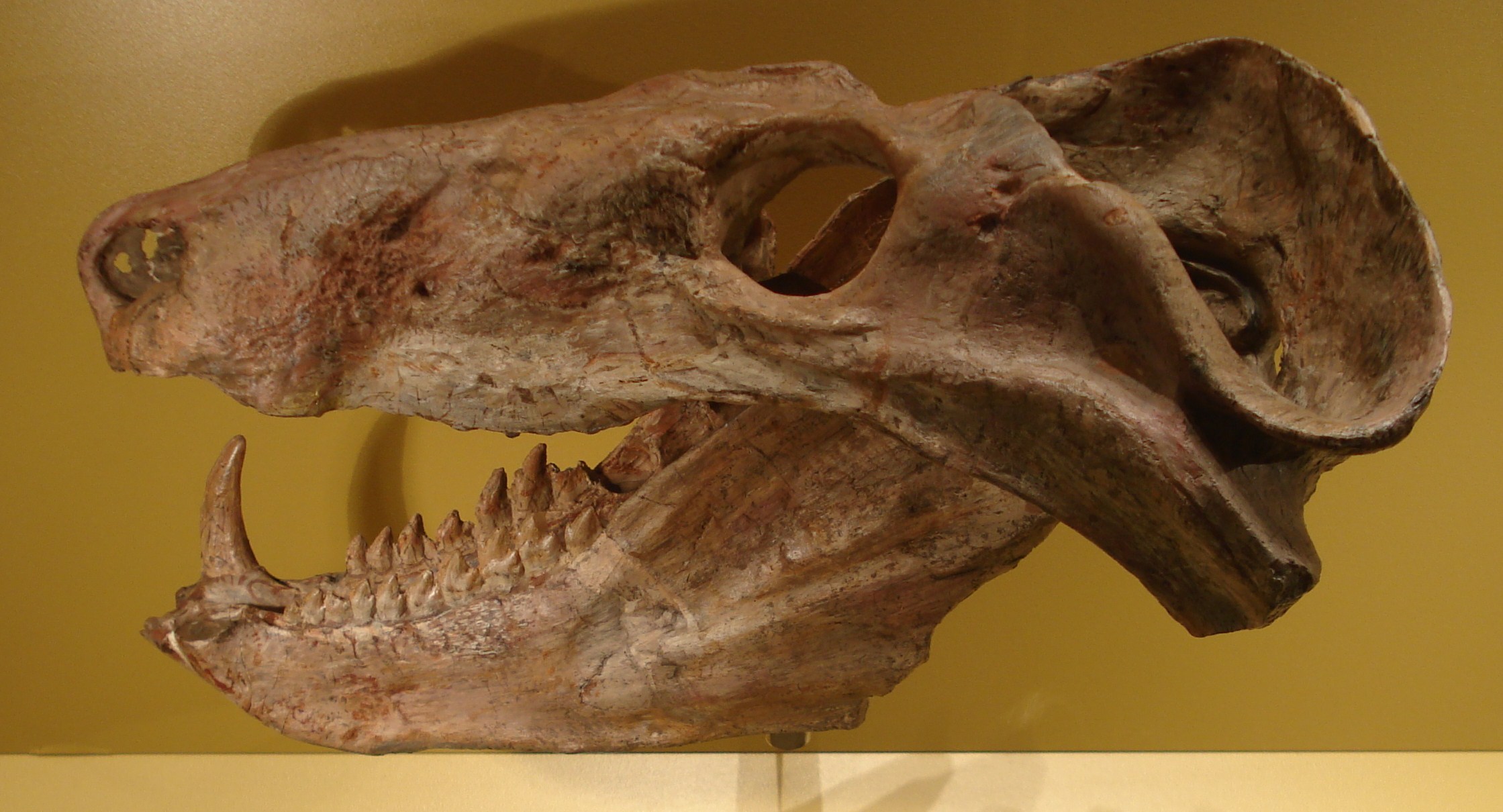
The Cynognathus had a lack of ribs in the stomach region suggesting the presence of an efficient diaphragm: an important muscle for mammalian breathing. Pits and canals on the bone of the snout indicated concentrations of nerves and blood vessels. These same structures allow hairs (whiskers) to be used as sensory organs on modern mammals.
The Cynognathus is an extinct genus of large-bodied cynodont therapsid that lived in the Early and Middle Triassic. The Cynognathus was a large predator, closely related to mammals, and had an almost worldwide distribution. Its hind limbs were placed directly beneath the body, like a mammal, but the fore-limbs sprawled outwards in a reptilian fashion. This form of double (erect/sprawling) gait is also found in some primitive mammals still alive today and are indicative of a transitional period.

It's dentary (mandible and lower jaw) was equipped with differentiated teeth that enabled the Cynoganthus to effectively process it's food before swallowing and the presence of a secondary palate in the mouth indicated that it could breathe and swallow simultaneously. The ability to breathe and swallow simultaneously is a trait common among mammals, as all mammals display this trait with the the only exception being humans due to the position of the larynx or the voice box. Although human babies can breathe and swallow at the same time because the larynx does not fully develop until the child reaches around 9 months of age.
The Cynognathus had a lack of ribs in the stomach region suggesting the presence of an efficient diaphragm: an important muscle for mammalian breathing. Pits and canals on the bone of the snout indicated concentrations of nerves and blood vessels. These same structures allow hairs (whiskers) to be used as sensory organs on modern mammals.
#4 Moschops
Name: Moschops (Cow-Face)
Age: 285 million years ago
Period: Early Permian
Size: 16.5 feet
Location(s) found: South Africa (Karoo region)
Notes:
Due to the presumably nutrient-poor food in their habitat the Moschops had to feed constantly. Its anatomy was unique in that it could spread its elbow joints widely, enabling it to move in a more mammal-like way compared to the other animals that walked on all fours at this time. This dexterity may have enabled the Moschops to carry a massive body more easily while feeding, which would have given it an edge over any rival species competing for territory and limited resources, like the the nutrient-lacking flora that composed their diet. This evolutionary advantage may have equipped it to survive under such harsh conditions, and if some theories are correct it may have ensured the eventual emergence of mammals roughly 85 million years later.

It is also possible that Moschops, and other dinocephalians, were semiaquatic given their heavy build and the fact that the limbs had spreading hands and feet splayed out wider and more separated than other land animals at that time. Their heavy skulls may have also been useful for diving after food. Moschops are Therapsids, which is a group of synapsids that include mammals and their ancestors. Many of the traits seen as unique to mammals had their origin with the early therapsids, like the Moschops, including the erect posture of humans.
Due to the presumably nutrient-poor food in their habitat the Moschops had to feed constantly. Its anatomy was unique in that it could spread its elbow joints widely, enabling it to move in a more mammal-like way compared to the other animals that walked on all fours at this time. This dexterity may have enabled the Moschops to carry a massive body more easily while feeding, which would have given it an edge over any rival species competing for territory and limited resources, like the the nutrient-lacking flora that composed their diet. This evolutionary advantage may have equipped it to survive under such harsh conditions, and if some theories are correct it may have ensured the eventual emergence of mammals roughly 85 million years later.

It is also possible that Moschops, and other dinocephalians, were semiaquatic given their heavy build and the fact that the limbs had spreading hands and feet splayed out wider and more separated than other land animals at that time. Their heavy skulls may have also been useful for diving after food. Moschops are Therapsids, which is a group of synapsids that include mammals and their ancestors. Many of the traits seen as unique to mammals had their origin with the early therapsids, like the Moschops, including the erect posture of humans.
#5 Dimetrodon
Name: Dimetrodon
Age(s): 299-260 million years ago
Period: Early-Mid Permian
Size: 10 feet
Notes:
The Dimetrodon is often mistaken for a dinosaur or as a contemporary of dinosaurs in popular culture, but it actually went extinct around 40 million years before the appearance of the first dinosaur in the Triassic period. Generally reptile-like in appearance and physiology, the Dimetrodon is nevertheless more-closely related to mammals than it is to any living reptilian group. Although it is not considered a direct ancestor of any modern mammal.
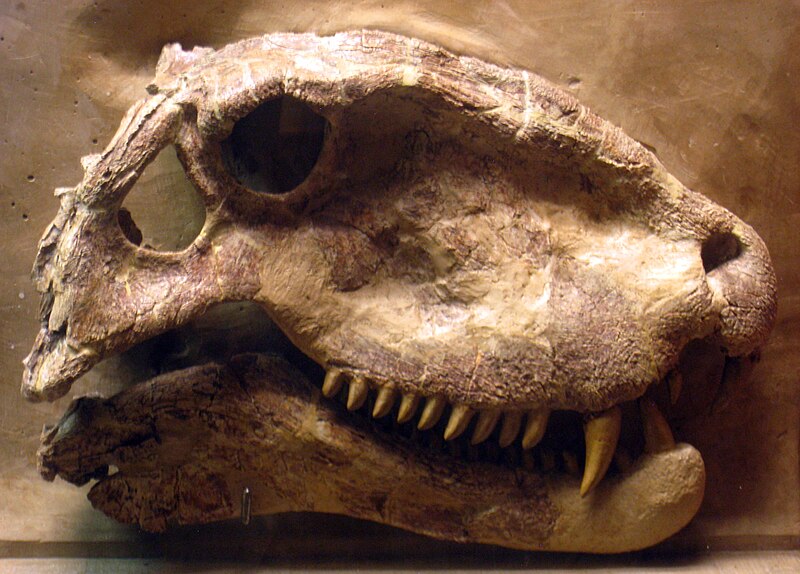
The Dimetrodon belongs to a group traditionally called "mammal-like reptiles," but more recently termed "stem-mammals" or "non-mammalian synapsids." Many vertebrate paleontologists group the Dimetrodon together with mammals, in an evolutionary group or clade called Synapsida, while dinosaurs are grouped with living reptiles and living birds in a separate group Sauropsida. The Dimetrodon may have been sexually dimorphic, meaning that the males and the females had slightly different body sizes, like humans.
The Dimetrodon is often mistaken for a dinosaur or as a contemporary of dinosaurs in popular culture, but it actually went extinct around 40 million years before the appearance of the first dinosaur in the Triassic period. Generally reptile-like in appearance and physiology, the Dimetrodon is nevertheless more-closely related to mammals than it is to any living reptilian group. Although it is not considered a direct ancestor of any modern mammal.

The Dimetrodon belongs to a group traditionally called "mammal-like reptiles," but more recently termed "stem-mammals" or "non-mammalian synapsids." Many vertebrate paleontologists group the Dimetrodon together with mammals, in an evolutionary group or clade called Synapsida, while dinosaurs are grouped with living reptiles and living birds in a separate group Sauropsida. The Dimetrodon may have been sexually dimorphic, meaning that the males and the females had slightly different body sizes, like humans.
5 Mammal-Like Reptiles and Dinosaurs, Oligokyphus, Thrinaxodon, Cynognathus, Moschops, synapsids, Dimetrodon, jurassic, triassic, non-dinosaur reptiles,5 Mammal-Like Reptiles and Dinosaurs, Oligokyphus, Thrinaxodon, Cynognathus, Moschops, synapsids, Dimetrodon, jurassic, triassic, non-dinosaur reptiles,5 Mammal-Like Reptiles and Dinosaurs, Oligokyphus, Thrinaxodon, Cynognathus, Moschops, synapsids, Dimetrodon, jurassic, triassic, non-dinosaur reptiles,5 Mammal-Like Reptiles and Dinosaurs, Oligokyphus, Thrinaxodon, Cynognathus, Moschops, synapsids, Dimetrodon, jurassic, triassic, non-dinosaur reptiles,5 Mammal-Like Reptiles and Dinosaurs, Oligokyphus, Thrinaxodon, Cynognathus, Moschops, synapsids, Dimetrodon, jurassic, triassic, non-dinosaur reptiles,5 Mammal-Like Reptiles and Dinosaurs, Oligokyphus, Thrinaxodon, Cynognathus, Moschops, synapsids, Dimetrodon, jurassic, triassic, non-dinosaur reptiles,5 Mammal-Like Reptiles and Dinosaurs, Oligokyphus, Thrinaxodon, Cynognathus, Moschops, synapsids, Dimetrodon, jurassic, triassic, non-dinosaur reptiles,5 Mammal-Like Reptiles and Dinosaurs, Oligokyphus, Thrinaxodon, Cynognathus, Moschops, synapsids, Dimetrodon, jurassic, triassic, non-dinosaur reptiles,5 Mammal-Like Reptiles and Dinosaurs, Oligokyphus, Thrinaxodon, Cynognathus, Moschops, synapsids, Dimetrodon, jurassic, triassic, non-dinosaur reptiles,5 Mammal-Like Reptiles and Dinosaurs, Oligokyphus, Thrinaxodon, Cynognathus, Moschops, synapsids, Dimetrodon, jurassic, triassic, non-dinosaur reptiles,5 Mammal-Like Reptiles and Dinosaurs, Oligokyphus, Thrinaxodon, Cynognathus, Moschops, synapsids, Dimetrodon, jurassic, triassic, non-dinosaur reptiles,5 Mammal-Like Reptiles and Dinosaurs, Oligokyphus, Thrinaxodon, Cynognathus, Moschops, synapsids, Dimetrodon, jurassic, triassic, non-dinosaur reptiles,5 Mammal-Like Reptiles and Dinosaurs, Oligokyphus, Thrinaxodon, Cynognathus, Moschops, synapsids, Dimetrodon, jurassic, triassic, non-dinosaur reptiles,


